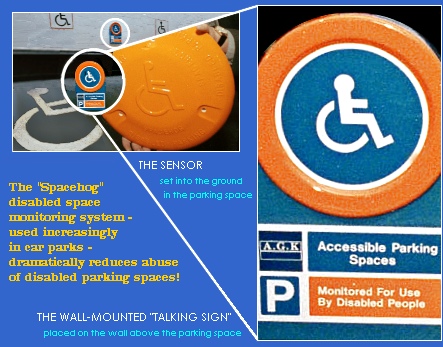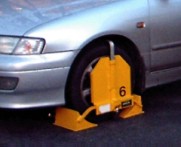
Article 1: Spacehog
Article 2: Clamping
|
This article was written for PALS by Keith Gavin of A.G.K. Limited Unit 2 Askea Business Park, O’ Brien Road, Carlow. Tel: 0503-36886; Fax: 0503-35185; Email: agk@ireland.com A.G.K. Limited are the suppliers for the Irish market, but would be happy to pass on enquiries from other countries! |
WATCH THIS SPACE!
- THE SPACEHOG MONITORED PARKING SOLUTION
An innovative solution to the ever-increasing problem of disabled parking bay abuse has recently been introduced into the Irish market. Known as Spacehog, the system has already been installed in a number of public car parks throughout the country.
The unique system was developed in the UK by Disabled Parking Systems Ltd. and it is estimated that over 250,000 disabled parking spaces will be protected by Spacehog systems by mid-2003. The system was developed as a result of several years’ research and development by the company and it won a Millenium Council Design Award. The system has been proven to dramatically reduce the incidence of disabled parking bay abuse from levels of 70%, pre-installation, to as low as 1% post-installation. Because of its unique design the system ha no ongoing maintenance requirements and costs as little as 5 cent a day over its operating life. The system has several advantages over conventional means of monitoring disabled parking bays as it eliminates the element of confrontation between parking attendants and inconsiderate motorists, as well as providing the parking operator with very detailed usage and occupancy statistics for their disabled parking spaces.
In October 2001, AGK Ltd. was granted the exclusive agency for the system in the Irish market and since then it has been installed at several sites throughout the country, including Stephens Green and Temple Bar Car Parks in Dublin city centre, Dublin Airport Short-Term Car Parks, Dun Laoghaire Harbour Ferry Terminal, Navan Shopping Centre, Carlow Shopping Centre, City Square Shopping Centre in Waterford, Arthurs Quay Shopping Centre in Limerick, and Blackrock Shopping Centre in Cork, and the system will soon be deployed in Cork Airport, and Douglas Court and Douglas Village Shopping Centres in Cork. The system can be customised to each individual car park as the Talking Signs and vehicle sensors can be fitted with each operators’ own logos and graphics and the recorded message is tailored to the requirements of each site. The system is having a positive impact on motorists’ behaviour and its implementation is being very favourably received throughout the country.
CLAMPING ENFORCEMENT -
Since the introduction of on-street parking enforcement by Dublin Corporation, the clamping and removal of illegally parked cars has become commonplace, and drivers who visit the City centre are more than aware of the controls and deterrents in place. Clamping is now also prevalent in all-major towns and cities across the length and breadth of the country.
The demand for free parking has also spread to more service orientated complexes such as shopping centres, hospitals, universities and hotels, where parking demands are increasing significantly again for staff and students, including all day parking and long term park and ride facilities.
Given these high parking demands, every available space has been taken up including the disabled spaces, which are being used by non-registered badge holders. This has been most prevalent in shopping centres, as disabled bays are located at convenient locations close to the centres’ doors.
To combat this, amongst other deterrents, premises owners have taken to:
Clamping, whilst seen a nasty and negative service, appears to be the only sure method of enforcing and protecting your disabled parking facility both efficiently and cost effectively. As long as the service is carried out in a professional and sensible manner, the desired effects result and are appreciated by those who need to use these spaces.
Where disabled bays in car parks are concerned, praise and support are often lavished on the attendants who are seen clamping in these areas - from both disabled drivers and able-bodied persons alike.
Extreme resentment and frustration has evolved over the last few years, with the increased demands for parking, and the abuse of the limited and conveniently located disabled spaces.
However it must also be noted that there is abuse of the disabled badge system. The badge is sometimes used by an able-bodied person rather than a disabled person (driving or being driven). Given the value of a disabled badge, not only in cost but in convenience, its abuse has become a serious issue across Ireland and Europe, along with the apparent ease with which one can sometimes obtain such a badge.
So, whilst praise should be given to the attendants who patrol the disabled bays, given the sensitive nature of enforcing the restriction on use (an able bodied person may be picking up a disabled pern, etc.), we must also be mindful of the increasing abuse of or fraudulent use of blue badges.
Jason Ballard October 2002
 The system relies on visual and audio cues to discourage able-bodied drivers from parking in disabled parking spaces. A vehicle sensor is installed in the disabled parking bay and this sensor triggers an adjacent ‘Talking Sign’ when a vehicle enters the space. The ‘Talking Sign’ then plays a recorded voice announcement informing the driver that the space has been reserved for drivers with special needs and that a valid permit is required to use the space (one ‘Talking Sign’ can be used to control up to eight adjacent parking bays). The entire system is based on internal batteries and low power radio links so that no electrical wiring is required for the installation of the system.
The system relies on visual and audio cues to discourage able-bodied drivers from parking in disabled parking spaces. A vehicle sensor is installed in the disabled parking bay and this sensor triggers an adjacent ‘Talking Sign’ when a vehicle enters the space. The ‘Talking Sign’ then plays a recorded voice announcement informing the driver that the space has been reserved for drivers with special needs and that a valid permit is required to use the space (one ‘Talking Sign’ can be used to control up to eight adjacent parking bays). The entire system is based on internal batteries and low power radio links so that no electrical wiring is required for the installation of the system.
Written for PALS by Jason Ballard, Managing Director of Nationwide Controlled Parking Systems Limited
Tel: 01 634 9805 Email: jballard@gofree.indigo.ie
A BLESSING FOR DISABLED DRIVERS
 Whilst clamping has been in operation within private parking since the early 1990’s, the requirement for controls in many new off street parking places has risen greatly since the on-street controls were introduced. Drivers, knowing the penalty for illegal parking on street, and the high parking charges for daily on and off street parking, will strive to find free off street parking.
Whilst clamping has been in operation within private parking since the early 1990’s, the requirement for controls in many new off street parking places has risen greatly since the on-street controls were introduced. Drivers, knowing the penalty for illegal parking on street, and the high parking charges for daily on and off street parking, will strive to find free off street parking.
Generally this is all to no avail, and on occasions they meet with an abusive reply.
Maximising Communication Skills | News | Newsletters | Brainteasers | PALS Personal Pages | Email PALS
